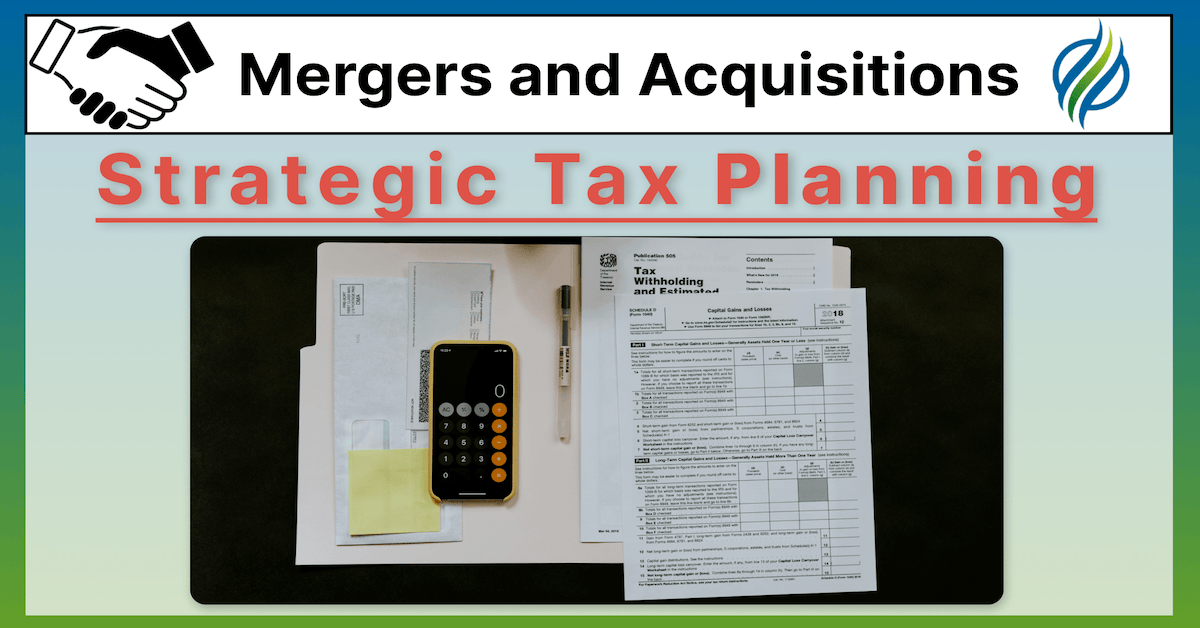In the complex world of business, mergers and acquisitions (M&As) are significant events that can drastically alter the course of a company’s future.
However, the excitement and potential of these transactions can quickly be overshadowed by the intricate web of tax implications that accompany them.
 Key Takeaways
Key Takeaways
- Strategic tax planning is essential for maximizing the value of business mergers and acquisitions.
- The structure of a deal, such as asset or stock purchases, significantly impacts its tax implications.
- Early and proactive tax planning can identify opportunities for tax savings and risk mitigation.
- Cross-border transactions require careful consideration of international tax laws and treaties.
- Engaging professional tax advisors ensures compliance and optimizes tax outcomes in complex transactions.
Understanding these tax considerations is not just a matter of legal compliance; it’s a strategic tool that can significantly impact the profitability and growth trajectory of your business.
At the heart of every successful M&A transaction lies strategic tax planning.
This proactive approach goes beyond mere compliance; it seeks to optimize the tax outcomes of the deal, ensuring that every decision made is not just legally sound but also financially astute.
The goal is simple: to maximize the value of the transaction for all parties involved, turning what could be a tax burden into a strategic advantage.
Why is this important?
Because taxes can account for a substantial portion of the total costs associated with M&As.
Without careful planning, these costs can erode the value of the deal, diminishing the anticipated benefits and growth prospects.
On the other hand, well-executed tax strategies can reduce these costs, enhance post-transaction profitability, and even create new opportunities for growth and expansion.
But strategic tax planning is not a one-size-fits-all solution.
It requires a deep understanding of the specific details of each transaction, the tax laws and regulations that apply, and the unique financial goals and circumstances of the businesses involved.
This is where the expertise of tax professionals becomes invaluable, guiding companies through the complexities of tax planning to ensure that every decision is aligned with their overall business strategy and growth objectives.
In essence, strategic tax planning in the context of M&As is about turning challenges into opportunities.
It’s about using the tax code not as a barrier but as a tool for creating value.
By embracing this mindset, companies can navigate the turbulent waters of business transactions with confidence, ensuring that their M&A deals are not just successful but also strategically sound and financially rewarding.
 Table of Contents
Table of Contents
The Impact of Taxes on Business Transactions

When it comes to business mergers and acquisitions (M&As), taxes are much more than just a line item on a balance sheet.
They are a dynamic force that can shape the entire structure and outcome of a deal.
Understanding this impact is crucial for anyone looking to navigate the M&A landscape successfully.
First and foremost, taxes can significantly influence how a transaction is structured.
For example, the choice between an asset purchase and a stock purchase can have profound tax implications for both the buyer and the seller.
In an asset purchase, the buyer can often write off the value of the acquired assets over time, leading to future tax deductions.
On the other hand, a stock purchase might be more favorable for the seller from a tax perspective, as it can result in lower capital gains taxes.
This is just one example of how taxes can shape a deal.
Every aspect of a transaction, from the payment terms to the allocation of liabilities, can have tax consequences that affect the overall value and feasibility of the deal.
That’s why it’s essential to consider taxes early in the transaction planning process.
Waiting until the last minute to address tax issues can lead to rushed decisions and suboptimal outcomes.
But the impact of taxes goes beyond just the structure of the deal.
They can also influence the timing of a transaction.
For instance, changes in tax laws or rates can create a window of opportunity for M&As.
Companies might rush to close deals before a tax increase takes effect or delay transactions to take advantage of a favorable tax environment.
The bottom line is that taxes are a critical factor in business transactions.
They can influence the structure, timing, and overall value of a deal.
By considering taxes early in the planning process and integrating tax strategies into the overall deal structure, companies can navigate the complexities of M&As more effectively and maximize the value of their transactions.
This proactive approach to tax planning is not just about compliance; it’s about turning taxes into a strategic asset that supports growth and profitability.
Tax Implications of Asset Purchases

In the realm of business mergers and acquisitions, asset purchases are a common strategy that can offer significant tax advantages.
But what exactly is an asset purchase, and how can it be structured for tax efficiency?
An asset purchase involves buying the assets of a company rather than its stock.
This can include tangible assets like equipment and real estate, as well as intangible assets such as patents and trademarks.
One of the key benefits of an asset purchase is the ability to “step up” the basis of the acquired assets to their fair market value.
This step-up allows the buyer to claim higher depreciation and amortization deductions, leading to significant tax savings over time.
For example, let’s say a company purchases a piece of machinery for $1 million in an asset purchase.
If the machinery has a fair market value of $1.5 million at the time of the acquisition, the buyer can step up the basis to $1.5 million and claim higher depreciation deductions based on this amount.
This not only reduces the buyer’s taxable income but also accelerates the tax benefits, providing a cash flow advantage.
To maximize the tax efficiency of an asset purchase, careful planning is required.
Here are some strategies to consider:
-
Identify and Allocate Value to Intangible Assets: Intangible assets like goodwill and intellectual property can often be amortized over a shorter period than tangible assets. Properly identifying and valuing these assets can lead to faster tax deductions.
-
Negotiate the Allocation of Purchase Price: The way the purchase price is allocated among different assets can impact the tax treatment. Buyers should negotiate an allocation that maximizes their tax benefits.
-
Consider the Impact on State and Local Taxes: The tax implications of an asset purchase can vary depending on state and local tax laws. It’s important to consider these implications when structuring the deal.
-
Evaluate the Potential for Bonus Depreciation: The U.S. tax code sometimes allows for bonus depreciation, which can provide an immediate deduction for a portion of the asset’s cost. Taking advantage of this provision can further enhance the tax benefits of an asset purchase.
Asset purchases offer a range of tax advantages that can significantly impact the overall value of a business transaction.
By understanding the tax implications and structuring the deal for tax efficiency, buyers can maximize their investment and support their long-term growth and profitability.
Tax Implications of Stock Purchases

In the world of business mergers and acquisitions, stock purchases offer a different set of opportunities and challenges compared to asset purchases.
Understanding the tax implications of stock purchases is crucial for both buyers and sellers to make informed decisions that align with their financial goals.
A stock purchase involves buying the shares of a company, effectively acquiring ownership of the company itself, including its assets and liabilities.
This method is often appealing to sellers because it allows for a clean exit from the business.
For buyers, stock purchases can be attractive because they may provide a simpler way to acquire an entire business without the need to individually transfer assets.
From a tax perspective, stock purchases are treated differently than asset purchases.
One of the key considerations is capital gains tax.
When a seller sells stock, the gain is typically subject to capital gains tax, which can be lower than the ordinary income tax rates that might apply to the sale of assets.
This can make stock purchases more tax-efficient for sellers.
However, stock purchases have their disadvantages for buyers.
Unlike in asset purchases, buyers in stock purchases do not get the benefit of stepping up the basis of the acquired assets to their fair market value.
This means that buyers cannot claim the same level of depreciation and amortization deductions, potentially resulting in higher taxable income and tax liability in the years following the acquisition.
Another consideration is the assumption of liabilities.
In a stock purchase, the buyer assumes all of the company’s liabilities, including any potential tax liabilities.
This can create additional risks for the buyer, which must be carefully evaluated during the due diligence process.
Despite these challenges, there are situations where stock purchases can be advantageous for buyers.
For example, if the target company has valuable tax attributes such as net operating loss carryforwards or tax credits, a stock purchase might allow the buyer to utilize these attributes to offset future taxable income.
Stock purchases offer a unique set of tax implications that can influence the structure and outcome of a business transaction.
Both buyers and sellers need to carefully consider these implications, along with their overall business objectives, to determine the best approach for their specific situation.
By doing so, they can maximize the benefits and minimize the risks associated with stock purchases in mergers and acquisitions.
Key Tax Considerations in Mergers and Acquisitions

Mergers and acquisitions (M&As) are pivotal moments in a company’s lifecycle, offering opportunities for growth, expansion, and strategic realignment.
However, navigating the tax landscape in these transactions is critical to ensure that the anticipated benefits are realized.
Here are some key tax considerations that should be at the forefront of any M&A strategy:
1. Understanding the Tax Structure of the Deal:
The way a merger or acquisition is structured can have significant tax implications.
For instance, a transaction can be structured as a taxable sale or a tax-free reorganization.
The choice between these structures depends on various factors, including the financial and tax positions of both the buyer and the seller.
2. Tax-Free Reorganizations:
The Internal Revenue Code provides for several types of reorganizations that can be conducted on a tax-free basis.
These reorganizations require careful planning and strict adherence to IRS regulations.
When structured properly, they can provide a way for companies to restructure their operations without incurring immediate tax liabilities.
3. Due Diligence:
Conducting thorough due diligence is essential in any M&A transaction.
This process involves reviewing the target company’s tax filings, assessing any potential tax liabilities, and understanding the tax implications of the company’s current and past operations.
Due diligence helps in identifying any tax risks that could affect the transaction and in planning strategies to mitigate these risks.
4. Valuation of Tax Attributes:
In M&A transactions, tax attributes such as net operating losses, tax credits, and capital loss carryforwards can be valuable assets.
The ability to use these attributes post-transaction can affect the valuation of the deal.
However, there are limitations and rules governing the use of these attributes after a merger or acquisition, which need to be carefully considered.
5. Cross-Border Considerations:
For transactions involving companies in different countries, understanding the tax implications in each jurisdiction is crucial.
This includes evaluating the impact of double taxation treaties, transfer pricing rules, and repatriation of earnings.
6. State and Local Tax Implications:
Beyond federal taxes, state and local taxes can also have a significant impact on M&A transactions.
The tax rules and rates can vary widely from one jurisdiction to another, affecting the overall tax burden of the combined entity.
7. Post-Merger Integration:
After the completion of an M&A transaction, integrating the tax functions of the two companies is a critical step.
This includes harmonizing tax reporting and compliance processes, aligning tax planning strategies, and ensuring the efficient use of tax attributes.
Tax considerations are integral to the success of mergers and acquisitions.
They influence the structure, valuation, and post-transaction integration of the companies involved.
By prioritizing tax planning and due diligence, companies can navigate the complexities of M&A transactions more effectively, minimizing risks and maximizing the strategic benefits of their business combinations.
Navigating Cross-Border Transactions

Cross-border mergers and acquisitions present a unique set of challenges, particularly when it comes to navigating the complexities of international tax laws.
Understanding these laws is crucial for companies looking to expand their global footprint while maximizing the financial benefits of such transactions.
One of the key considerations in cross-border deals is the impact of tax treaties.
Tax treaties are agreements between two or more countries that aim to avoid double taxation and prevent tax evasion.
They outline the tax rights of each country and provide mechanisms for resolving disputes.
Companies engaged in cross-border M&As must be aware of the relevant tax treaties to ensure that they are not paying more tax than necessary.
For example, a tax treaty may reduce the withholding tax rate on dividends, interest, and royalties paid by a subsidiary to its foreign parent company.
Another critical aspect of cross-border transactions is transfer pricing regulations.
Transfer pricing refers to the prices at which goods, services, and intangible assets are traded between related entities within a multinational enterprise.
Tax authorities closely scrutinize these transactions to ensure that they are conducted at arm’s length, meaning that the prices are consistent with those that would be charged between unrelated parties.
Failure to comply with transfer pricing regulations can result in significant penalties and adjustments to taxable income.
To navigate the complexities of cross-border transactions effectively, companies should consider the following strategies:
1. Conduct Thorough Due Diligence:
Before entering into a cross-border transaction, companies should conduct a comprehensive review of the target company’s tax positions and risks.
This includes understanding the tax laws and regulations in the target company’s country, as well as any potential exposure to tax liabilities.
2. Engage with Tax Advisors:
Working with tax advisors who have expertise in international tax law is essential.
These advisors can provide guidance on structuring the transaction to minimize tax liabilities and ensure compliance with tax laws in all relevant jurisdictions.
3. Consider the Impact of Exchange Rates:
Fluctuations in exchange rates can have a significant impact on the value of cross-border transactions.
Companies should consider strategies to manage currency risk, such as hedging.
4. Plan for Post-Merger Integration:
Integrating the tax functions of two companies across different countries requires careful planning.
Companies should establish clear processes for tax reporting, compliance, and planning in the post-merger environment.
Navigating the complexities of international tax laws is a critical aspect of successful cross-border mergers and acquisitions.
By understanding tax treaties, transfer pricing regulations, and other tax considerations, companies can structure their transactions in a way that maximizes financial benefits while ensuring compliance with tax laws in all relevant jurisdictions.
Strategies for Tax-Efficient Business Transactions

In the world of business mergers and acquisitions, tax efficiency is a key factor that can significantly impact the success and profitability of a transaction.
By employing strategic tax planning, companies can structure their deals in a way that minimizes tax liabilities and maximizes financial benefits.
Here are some practical strategies for achieving tax-efficient business transactions:
1. Choose the Right Transaction Structure:
As discussed earlier, the structure of a deal (e.g., asset purchase vs. stock purchase) can have major tax implications.
Companies should carefully evaluate their options and choose a structure that offers the most tax advantages for their specific situation.
2. Leverage Tax Attributes:
Utilizing tax attributes such as net operating losses, tax credits, and capital loss carryforwards can reduce taxable income and provide significant tax savings.
Companies should assess the availability and usability of these attributes in the context of the transaction.
3. Optimize the Use of Debt:
The way a transaction is financed can also affect its tax efficiency.
For example, using debt financing can provide tax deductions for interest payments, which can reduce the overall tax burden of the transaction.
4. Consider the Timing of the Transaction:
The timing of a merger or acquisition can influence its tax implications.
For instance, completing a deal at the end of the fiscal year might allow for immediate tax deductions, whereas closing at the beginning of the year could defer tax liabilities.
5. Plan for Post-Transaction Integration:
After the deal is closed, integrating the tax functions of the merged companies is crucial for maintaining tax efficiency.
This includes aligning tax reporting and compliance processes, as well as optimizing the combined company’s tax strategy.
The role of professional tax advisors in ensuring compliance and optimizing tax outcomes cannot be overstated.
These experts bring a deep understanding of tax laws and regulations, as well as experience in structuring complex business transactions.
They can provide invaluable guidance on the following:
-
Tax Due Diligence: Identifying potential tax liabilities and risks associated with the target company.
-
Tax Structuring: Advising on the most tax-efficient structure for the transaction.
-
Compliance: Ensuring that the transaction complies with all applicable tax laws and regulations.
-
Tax Optimization: Developing strategies to minimize tax liabilities and maximize the use of tax attributes.
Achieving tax efficiency in business mergers and acquisitions requires careful planning and strategic decision-making.
By employing the right strategies and working with professional tax advisors, companies can navigate the complexities of tax laws and regulations, minimize their tax liabilities, and maximize the value of their transactions.
Practical Examples: Successful Tax Planning in Business Transactions

To illustrate the power of strategic tax planning in mergers and acquisitions, let’s explore a couple of real-world examples where effective tax management played a pivotal role in the success of business transactions:
Example 1: Acquisition of a Technology Company
-
Background: A large corporation was interested in acquiring a smaller technology company to expand its product offerings. The target company had significant intellectual property assets and net operating losses (NOLs).
-
Applied Tax Strategy: The acquisition was structured as a stock purchase to preserve the target company’s NOLs, which could be used to offset future taxable income. Additionally, the valuation of intellectual property assets was carefully managed to optimize amortization deductions.
-
Outcome: The strategic use of NOLs and amortization deductions resulted in substantial tax savings for the acquiring company, enhancing the overall value of the transaction. The acquisition also allowed the company to diversify its product portfolio and enter new markets, driving long-term growth and profitability.
Example 2: Cross-Border Merger in the Manufacturing Sector
-
Background: Two manufacturing companies, one based in the United States and the other in Germany, decided to merge to consolidate their market position and achieve economies of scale.
-
Applied Tax Strategy: The merger was structured to take advantage of tax treaty benefits between the two countries, reducing withholding taxes on cross-border payments. Transfer pricing policies were also established to ensure compliance with international tax regulations and optimize the tax treatment of intercompany transactions.
-
Outcome: The merger led to a more competitive global presence for the combined entity, with improved operational efficiencies and cost savings. The tax-efficient structure of the transaction minimized the tax burden and contributed to the financial stability of the newly merged company.
Example 3: Restructuring of a Retail Chain
-
Background: A multinational retail chain sought to restructure its operations to streamline efficiency and reduce costs. The company had stores in multiple countries, each with its own set of tax regulations.
-
Applied Tax Strategy: The restructuring was planned with a focus on consolidating operations in jurisdictions with favorable tax rates and incentives. The company also utilized tax-efficient financing methods to fund the restructuring process.
-
Outcome: The strategic restructuring led to a significant reduction in the company’s overall tax liability, freeing up capital for further investment and growth. The streamlined operations resulted in increased profitability and a stronger market position.
➤ MORE: Global Retail Outlook 2024
Example 4: Spin-off of a Business Unit
-
Background: A large conglomerate decided to spin off one of its business units into a separate, publicly traded company to unlock shareholder value and focus on its core operations.
-
Applied Tax Strategy: The spin-off was structured as a tax-free distribution to existing shareholders, in accordance with IRS regulations. This allowed the shareholders to receive shares in the new company without incurring immediate tax liabilities.
-
Outcome: The tax-free spin-off was well-received by the market, leading to an increase in shareholder value for both the parent company and the newly formed entity. The strategic separation allowed both companies to pursue more focused growth strategies.
Example 5: Acquisition of a Renewable Energy Company
-
Background: An energy conglomerate aimed to expand its portfolio into renewable energy and sought to acquire a smaller company specializing in solar power.
-
Applied Tax Strategy: The acquisition was structured to take advantage of various tax credits and incentives available for renewable energy investments. The deal was also timed to coincide with the expiration of certain tax credits, maximizing the financial benefits.
-
Outcome: The acquisition not only diversified the conglomerate’s energy portfolio but also resulted in significant tax savings due to the utilization of renewable energy tax credits. This strategic move positioned the company as a leader in sustainable energy and enhanced its long-term profitability.
➤ MORE: Global M&A Trends in Energy, Utilities & Resources
Lessons Learned:
-
Proactive Tax Planning: In both cases, early and proactive tax planning was crucial in identifying and capitalizing on tax-saving opportunities.
-
Structural Flexibility: Flexibility in structuring the transactions allowed the companies to adapt to the unique tax attributes of each situation, maximizing the benefits.
-
International Considerations: For cross-border transactions, understanding the tax implications in different jurisdictions and leveraging tax treaties can lead to significant savings.
-
Sector-Specific Opportunities: Different industries offer unique tax planning opportunities, such as renewable energy tax credits in the energy sector. Understanding these nuances can lead to substantial tax savings.
-
Timing is Key: The timing of a transaction can greatly influence its tax implications. Aligning a deal with the expiration or introduction of tax laws can optimize its financial outcome.
-
Tax Efficiency in Financing: The way a transaction is financed can have a significant impact on its tax efficiency. Utilizing tax-efficient financing methods can reduce the overall cost of the transaction.
These case studies demonstrate that effective tax planning can significantly impact the success of business transactions.
By carefully leveraging tax implications and structuring deals accordingly, companies can not only comply with tax regulations but also enhance their growth and profitability.
Quick Recap

As we’ve explored throughout this article, strategic tax planning is a critical component of successful business mergers and acquisitions.
By understanding and effectively managing the tax implications of these transactions, companies can unlock significant value and pave the way for long-term growth and profitability.
Key takeaways include:
-
The Impact of Taxes: Taxes can significantly influence the structure and outcome of business transactions. Understanding these implications is essential for making informed decisions.
-
Tax-Efficient Structuring: Whether it’s an asset purchase, a stock purchase, or a cross-border transaction, structuring deals with tax efficiency in mind can lead to substantial savings and enhanced value.
-
The Role of Professional Advisors: Navigating the complexities of tax laws and regulations requires expertise. Engaging with professional tax advisors ensures compliance and optimizes tax outcomes.
-
Proactive Planning: Early and proactive tax planning is crucial. It allows businesses to identify opportunities, mitigate risks, and align their tax strategies with their overall business objectives.
As business owners and executives, adopting a proactive approach to tax planning is not just about compliance; it’s about turning taxes into a strategic asset that supports your company’s growth and success.
By integrating tax considerations into the planning and execution of your mergers and acquisitions, you can make informed decisions that maximize the value of your transactions and position your business for long-term success.
Strategic tax planning is an indispensable tool in the world of business mergers and acquisitions.
By embracing this approach, you can navigate the complexities of tax laws with confidence, unlock the full potential of your transactions, and drive your business forward on a path of growth and prosperity.
In Summary…
As we conclude our journey through the intricacies of strategic tax planning in business mergers and acquisitions, it’s clear that navigating these waters requires a blend of knowledge, foresight, and expert guidance.
By integrating tax considerations into the planning and execution of business transactions, companies can unlock a multitude of benefits that go beyond mere compliance.
Benefits of Strategic Tax Planning:
1. Financial Savings:
Effective tax planning can lead to significant financial savings by minimizing tax liabilities and maximizing deductions and credits.
2. Risk Mitigation:
Proactively addressing potential tax risks can prevent costly surprises and legal issues down the line.
3. Value Enhancement:
By structuring deals with tax efficiency in mind, companies can enhance the overall value of the transaction, leading to greater profitability and growth potential.
4. Strategic Advantage:
In the competitive landscape of mergers and acquisitions, having a well-thought-out tax strategy can provide a crucial edge over competitors.
The intricate dance of mergers and acquisitions is a high-stakes game where every move counts.
As we’ve explored in this article, one of the most critical yet often overlooked aspects of this process is strategic tax planning.
Here are some proactive steps you can take today to ensure your business transactions are not only compliant but also strategically advantageous:
1. Seek Professional Advice:
- Engage with tax professionals who specialize in mergers and acquisitions.
Their expertise can provide you with invaluable insights into the tax implications of your transactions and help you develop strategies that align with your business goals.
- Consider forming a long-term partnership with a reputable tax advisor.
This relationship can provide ongoing support and ensure that your tax planning remains agile in response to changing laws and business needs.
2. Stay Informed:
- Make a commitment to stay updated on tax regulations and changes in the tax landscape.
This can involve subscribing to tax law newsletters, attending seminars, and participating in industry forums.
- Encourage a culture of continuous learning within your organization.
Empower your team with the knowledge and tools they need to recognize the tax implications of business decisions.
3. Integrate Tax Planning into Your Business Strategy:
-
Recognize that tax planning is not just a compliance activity but a strategic function that can impact the bottom line of your transactions.
-
Ensure that tax considerations are integrated into your business planning processes from the outset.
-
This proactive approach can help you identify opportunities and avoid potential pitfalls.
4. Leverage Technology:
-
Consider utilizing tax software and tools that can help streamline your tax planning and compliance processes.
-
These technologies can provide real-time insights and assist in scenario planning.
5. Build a Network of Experts:
-
Develop relationships with legal advisors, financial analysts, and other professionals who can provide complementary insights into your transactions.
-
A multidisciplinary approach can help you navigate the complexities of mergers and acquisitions more effectively.
By taking these steps, you can position your business to navigate the complexities of tax planning with confidence.
Remember, strategic tax planning is not just about minimizing liabilities; it’s about maximizing opportunities and driving the long-term success of your business.
So, take charge, seek expert advice, and embrace the strategic potential of tax planning in your business transactions.
Don’t let taxes be an afterthought in your business transactions!
Take control of your financial future by embracing strategic tax planning.
If you’re looking for expert guidance and tailored advice, Business Initiative is here to help.
Schedule a consultation call with us or use our contact form to start optimizing your tax strategy today.
Stay ahead of the curve by subscribing to the Business Initiative newsletter and following us on X (Twitter) for the latest insights and updates.
In the dynamic world of mergers and acquisitions, strategic tax planning is not just a necessity—it’s a strategic advantage.
Let Business Initiative help you unlock this potential and pave the way for your business’s success.
Sources
- pwc - Mergers & acquisitions tax services
- Deloitte - The future of M&A
- Clean Slate Tax - Understanding the Tax Implications of Business Mergers and Acquisitions
- Deloitte - Why tax should be brought into strategic business decisions early
- Journel of Accountancy - Full disclosure: When tax transactions must be reported
- The Consultancy Group - Mergers and Acquisitions: Navigating the Tax Implications
- Corporate Financial Institute - Asset Purchase vs Stock Purchase
- Wall Street Prep - Asset Sale vs Stock Sale
- CLA Global - Stock or Asset Transaction? Tax Considerations for Mergers and Acquisitions
- The M&A Lawyer Blog - Anatomy of a Stock Purchase Agreement
- The Tax Advisor - Comparing stock sales and asset sales of S corporations
- Investopedia - Capital Gains Tax: What It Is, How It Works, and Current Rates
- KPMG - Mergers & Acquisitions Tax
- Deloitte - M&A Tax
- Deloitte - 2024 M&A Trends Survey: Mind the gap
- KPMG - United States - Taxation of cross-border mergers and acquisitions
- Wachtell, Lipton, Rosen & Katz - Cross-Border M&A Guide
- Baker McKenzie - Cross-Border M&A Index
- The Daily CPA - 4 Tax Strategies for Your Next M&A Deal
- CBIZ - 4 Tax Moves to Consider if Planning for M&A
- Linkedin - What are the best strategies for tax-efficient deal structuring?
- Deloitte - M&A Tax Talk
- Deloitte - Dell, EMC, and Deloitte create the next tech icon
- pwc - How recent tax developments could impact M&A deals
- Bain & Company - Retail’s New M&A Balancing Act
- Deloitte - Global Retail Outlook 2024
- Bain & Company - Consumer Products M&A: Creating Value by Acquiring Insurgent Brands
- McKinsey & Company - Achieving win-win spin-offs
- pwc - What it takes for your spin-off to deliver value
- McKinsey & Company - A case for restructuring before spin-off
- iea - Renewables 2023 Executive summary
- pwc - Global M&A Trends in Energy, Utilities & Resources
- Deloitte - 2023 power, utilities, and renewables M&A outlook


